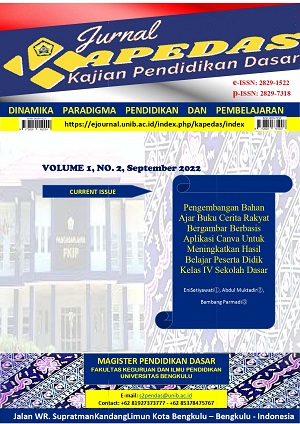Main Article Content
Abstract
Keywords
Article Details
Copyright (c) 2022 Mei Feri Zami

This work is licensed under a Creative Commons Attribution-ShareAlike 4.0 International License.

Karya ini dilisensikan di bawah Creative Commons Attribution-ShareAlike 4.0 International License .
References
- Basuki, I., & Hariyanto. (2017). Asesmen Pembelajaran. Bandung: PT. Remaja Rosdakarya.
- BSNP. (2018). Buletin BSNP: Media Komunikasi dan Dialog Standar Pendidikan. Jakarta: BSNP.
- Dahar, R. W. (2003). Teori-teori belajar. Jakarta: Gelora Aksara Prima.
- Huda, N. dan Wahyuni, T. S.. (2019). Analisis Butir Soal IPA Try Out USBN Tahun Ajaran 2018/2019 dalam Kaitannya dengan Level Kognitif. MADRASAH: Jurnal Pendidikan dan Pembelajaran Dasar, 12 (1), 29-39.
- Kemdikbud. (2016). Peraturan Menteri Pendidikan dan Kebudayaan Republik Indonesia Nomor 20 Tahun 2016 Tentang Standar Kompetensi Lulusan. Jakarta: Kemendikbud.
- Kholifah, U., Hanifah, & Siagian, T.A. (2021). Analisis Soal Matematika Ujian Akhir Semester Ganjil Ditinjau dari Aspek Kognitif Pada Siswa Kelas VII SMP Negeri 13 Mukomuko Tahun Ajaran 2019/2020. Jurnal Penelitian Pembelajaran Matematika Sekolah, 5 (1), 99-110.
- Majid, A,. (2017). Penilaian Autentik: Proses dan Hasil Belajar. Bandung: PT. Remaja Rosdakarya.
- Sugiyono. (2020). Metode Penelitian Kuantitatif, Kualitatif, dan, R & D. Bandung: Alfabeta.
- Wijaya, A., Eresti, A., Despa, D., & Walid, A. (2019). Analisis butir soal persiapan ujiannasional IPA SMP/MTS tahun 2018 sampai dengan 2019 berdasarkan taksonomiBloom. Jurnal Pendidikan IPA, 9(2): 57-63.
- Winarni, E. W. (2018). Teori dan Praktik Penelitian Kuantitatif Kualitatif Penelitian Tindakan Kelas (PTK) Reseach And Development (R&D). Jakarta: Bumi Aksara.
References
Basuki, I., & Hariyanto. (2017). Asesmen Pembelajaran. Bandung: PT. Remaja Rosdakarya.
BSNP. (2018). Buletin BSNP: Media Komunikasi dan Dialog Standar Pendidikan. Jakarta: BSNP.
Dahar, R. W. (2003). Teori-teori belajar. Jakarta: Gelora Aksara Prima.
Huda, N. dan Wahyuni, T. S.. (2019). Analisis Butir Soal IPA Try Out USBN Tahun Ajaran 2018/2019 dalam Kaitannya dengan Level Kognitif. MADRASAH: Jurnal Pendidikan dan Pembelajaran Dasar, 12 (1), 29-39.
Kemdikbud. (2016). Peraturan Menteri Pendidikan dan Kebudayaan Republik Indonesia Nomor 20 Tahun 2016 Tentang Standar Kompetensi Lulusan. Jakarta: Kemendikbud.
Kholifah, U., Hanifah, & Siagian, T.A. (2021). Analisis Soal Matematika Ujian Akhir Semester Ganjil Ditinjau dari Aspek Kognitif Pada Siswa Kelas VII SMP Negeri 13 Mukomuko Tahun Ajaran 2019/2020. Jurnal Penelitian Pembelajaran Matematika Sekolah, 5 (1), 99-110.
Majid, A,. (2017). Penilaian Autentik: Proses dan Hasil Belajar. Bandung: PT. Remaja Rosdakarya.
Sugiyono. (2020). Metode Penelitian Kuantitatif, Kualitatif, dan, R & D. Bandung: Alfabeta.
Wijaya, A., Eresti, A., Despa, D., & Walid, A. (2019). Analisis butir soal persiapan ujiannasional IPA SMP/MTS tahun 2018 sampai dengan 2019 berdasarkan taksonomiBloom. Jurnal Pendidikan IPA, 9(2): 57-63.
Winarni, E. W. (2018). Teori dan Praktik Penelitian Kuantitatif Kualitatif Penelitian Tindakan Kelas (PTK) Reseach And Development (R&D). Jakarta: Bumi Aksara.
